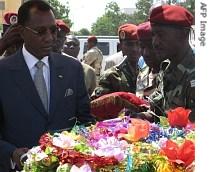2006年VOA标准英语-Fears Rise Over Chad Violence(在线收听)
By Naomi Schwarz
Dakar
07 November 2006
Chad's government is reporting new clashes between non-Arab and Arab communities, amid fears such violence is spreading in the region.
 Chadian President Idriss Deby pays his respects in Ndjamena to the late deputy Army Chief of Staff killed during clashes between rebels and the Chadian Army in the East of the Country |
||
Details of the attack are still being confirmed, says the minister's cabinet chief.
"We have been informed that there was an intercommunity conflict," says Bany Ganosso, head of the cabinet for the administration minister. The minister has gone to the site and we are awaiting his report, he says.
The country shares a long border with Sudan's Darfur region. For more than three years, the conflict there has spilled over the border into Chad.
Hundreds of thousands of Sudanese refugees have fled to Chad. Darfur-based "Janjaweed" militias have followed, attacking Sudanese refugees and Chadians, alike. And Chadian rebels operate from bases in Darfur.
But this latest report puts violence deeper into Chadian territory. The villages involved, says Ganosso, are between 100 and 200 kilometers from the border.
Adrien Feniou is an analyst at the London-based research group Global Insight.
"It is much easier to function in a war situation as a nomadic tribe than a farmer,” he noted. “You have the potential to move out. So it is possible that these people who are moving are causing instability for the farmers and putting pressure on the resources there."
But Feniou says that, although the violence is in a different location, it is still part of the same conflict.
"To me it just appears to be part of the wider conflict. It does not seem to be a specific to a brewing ethnic in eastern Chad," he added.
There have long been conflicts between herders and farmers along the Sahel region, where the desert meets grassland. Although these conflicts are sometimes described as between "Arabs" and non-Arabs, Feniou says the ethnic distinctions are far more complex and localized.